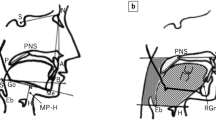Abstract
The localization of the obstruction is crucial in determining the appropriate surgical treatment for obstructive sleep apnea syndrome (OSAS); ApneaGraph has been introduced for diagnosis of OSAS and localization of airway obstruction level. This study aims to evaluate the diagnostic value of ApneaGraph for both clinical staging and site of obstruction. Thirty male OSAS patients were prospectively enrolled in this clinical trial. The following parameter were included to the study: Body mass indexes and neck circumferences of the subjects, Epworth sleepiness scale, site of obstruction detected by flexible endoscopy and ApneaGraph, apnea hypopnea index (AHI), apnea index, hypopnea index, maximal oxygen desaturation and average oxygen saturation which were detected by both polysomnography (PSG) and ApneaGraph devices. Our data presented that, although AHI measured by ApneaGraph and PSG were significantly correlated; severity stages of the subjects were different in 44 % of the subjects when based on AHI of ApneaGraph, compared to PSG. Majority of the changes were from severe OSAS to mild or moderate levels. Similar dominant collapse levels were detected in 64 % of the subjects by both devices. It was seen that transpalatal obstruction was better correlated between ApneaGraph and flexible endoscopy. As a conclusion, we might assume that ApneaGraph can be used as a screener for OSAS and it appears to be a more reliable device to confirm dominancy of palatal level obstruction.


Similar content being viewed by others
References
Epstein LJ, Weiss JW (1998) Clinical consequences of obstructive sleep apnea. Semin Respir Crit Care Med 19(2):23–132
Force AOSAT, Medicine AAoS, (2009) Clinical guideline for the evaluation, management and long-term care of obstructive sleep apnea in adults. J Clin Sleep Med 5(3):263
Fujita S (1984) UPPP for sleep apnea and snoring. Ear Nose Throat J 63(5):227
Hudgel DW, Harasick T, Katz RL, Witt WJ, Abelson T (1991) Uvulopalatopharyngoplasty in obstructive apnea. Am Rev Respir Dis 143:942–946
Isono S, Remmers J (1993) Site of pharyngeal narrowing predicts outcome of surgery for obstructive sleep apnea. Am Rev Respir Dis 147:182–189
Rama AN, Tekwani SH, Kushida CA (2002) Sites of obstruction in obstructive sleep apnea. Chest J 122(4):1139–1147
Singh A, Al-Reefy H, Hewitt R, Kotecha B (2008) Evaluation of ApneaGraph in the diagnosis of sleep-related breathing disorders. Eur Arch Otorhinolaryngol 265(12):1489–1494. doi:10.1007/s00405-008-0685-x
Achar P, Kumar BN (2014) Can apneagraphy change our approach in management of snoring and sleep apnoea? Indian J Otolaryngol Head Neck Surg 66(Suppl 1):110–114. doi:10.1007/s12070-011-0344-1
Skatvedt O, Akre H, Godtlibsen O (1996) Nocturnal polysomnography with and without continuous pharyngeal and esophageal pressure measurements. Sleep 19(6):485–490
Tvinnereim M, Miljeteig H (1992) Pressure recordings-a method for detecting site of upper airway obstruction in obstructive sleep apnea syndrome. Acta Otolaryngol 112(S492):132–140
Tvinnereim M, Cole P, Haight JS, Hoffstein V (1995) Diagnostic airway pressure recording in sleep apnea syndrome. Acta Otolaryngol 115(2):449–454
Tvinnereim M, Mateika S, Cole P, Haight J, Hoffstein V (1995) Diagnosis of obstructive sleep apnea using a portable transducer catheter. Am J Respir Crit Care Med 152(2):775–779
Morales Divo C, Selivanova O, Mewes T, Gosepath J, Lippold R, Mann WJ (2009) Polysomnography and ApneaGraph in patients with sleep-related breathing disorders. ORL J Otorhinolaryngol Relat Spec 71(1):27–31. doi:10.1159/000165683
Yu R, Li W, Huo H, Shen P, Tian X (2011) Short daytime ApneaGraph for initial case selection of obstructive sleep apnea-hypopnea syndrome before surgery. Eur Arch Otorhinolaryngol 268(11):1663–1669. doi:10.1007/s00405-011-1564-4
Moser NJ, Phillips BA, Berry D, Harbison L (1994) What is hypopnea, anyway? Chest J 105(2):426–428
Woodson BT, Wooten MR (1992) A multisensor solid-state pressure manometer to identify the level of collapse in obstructive sleep apnea. Otolaryngol-Head Neck Surg 107(5):651–656
Rollheim J, Osnes T, Miljeteig H (1999) The sites of obstruction in OSA, identified by continuous measurements of airway pressure and flow during sleep: ambulatory versus in-hospital recordings. Clin Otolaryngol Allied Sci 24(6):502–506
Rollheim J, Tvinnereim M, Sitek J, Osnes T (2001) Repeatability of sites of sleep-induced upper airway obstruction. A 2-night study based on recordings of airway pressure and flow. Eur Arch Otorhinolaryngol 258(5):259–264
Farmer WC, Giudici SC (2000) Site of airway collapse in obstructive sleep apnea after uvulopalatopharyngoplasty. Ann Otol Rhinol Laryngol 109(6):581–584
Tvinnereim M, Mitic S, Hansen RK (2007) Plasma radiofrequency preceded by pressure recording enhances success for treating sleep-related breathing disorders. Laryngoscope 117(4):731–736. doi:10.1097/MLG.0b013e31803250f0
Rollheim J, Osnes T, Miljeteig H (1997) The relationship between obstructive sleep apnoea and body mass index. Clin Otolaryngol Allied Sci 22(5):419–422
Acknowledgments
We declare that this study was funded by Gazi University Scientific Research Projects Unit, Turkey (Grant number 01/2012-85).
Author information
Authors and Affiliations
Corresponding author
Ethics declarations
Conflict of interest
None of the authors received any research grant, a speaker honorarium from any company. All authors declare that they have no conflict of interest.
Ethical standards
All procedures performed in studies involving human participants were in accordance with the ethical standards of the institutional and/or national research committee and with the 1964 Helsinki declaration and its later amendments or comparable ethical standards (Ethical approval no: 27/06/2012-286).
Human and animal rights
This article does not contain any studies with animals performed by any of the authors.
Informed consent
Informed consent was obtained from all individual participants included in the study.
Rights and permissions
About this article
Cite this article
Karaloğlu, F., Kemaloğlu, Y.K., Yilmaz, M. et al. Comparison of full-night and ambulatory polysomnography with ApneaGraph in the subjects with obstructive sleep apnea syndrome. Eur Arch Otorhinolaryngol 274, 189–195 (2017). https://doi.org/10.1007/s00405-016-4162-7
Received:
Accepted:
Published:
Issue Date:
DOI: https://doi.org/10.1007/s00405-016-4162-7




